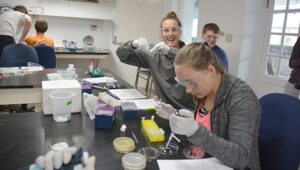From Contaminants to Cures, Furman Undergrads Connect Ocean and Human Health at BIOS

Marine science isn’t a prerequisite for medical school, but last month 13 pre-medical and health students from Furman University traveled to BIOS to spend three weeks delving into marine science for human good. They were participating in the second offering of BIOS’s interdisciplinary Oceans and Human Health course, which is co-taught by two Furman biology professors and four BIOS scientists. Through lectures, field trips, and hands-on research projects, the course covers how human health benefits from marine life, as well as the potential threats facing humans and marine organisms, and risk management and policy implications.
Within the first three days of the course students were already immersed in a marine natural products discovery project. Many successful drugs have been derived from plants and animals on land, and marine biodiversity is thought to contain a treasure trove of novel compounds waiting to be discovered. The class had collected samples to test for antimicrobial properties while snorkeling in Harrington Sound, and back in the lab tubes with bits of seaweed, sponges, and even a limp comb jelly were systematically being measured and mashed up. Liquefied samples were pipetted onto paper disks the size of a pencil eraser, and the disks were placed on a bacteria-coated petri dish to test whether they inhibited bacterial growth as well as the commonly prescribed antibiotic tetracycline. Informally, some of the students were betting on the antibiotic potential of an intriguing slime.
In the lab, BIOS scientist Andrea Bodnar and Furman biology professor Allison Roark helped the students master common biomedical laboratory skills. They gave tips on how to successfully plate a smooth coat of bacteria onto the petri dish without stabbing a hole in the gel, and the finer skills of knowing when a freshly flame-sterilized glass rod is cool enough to use without killing the bacterial culture. The prepared plates were divided into sections and labeled, and samples and controls were all neatly placed in their assigned quadrants. After 24 hours in the incubator, the students would return to see whether any of their samples had inhibited the freshly grown lawn of bacteria on the plate.
Drug discovery from marine natural products is just one topic that falls under the “Oceans and Human Health” umbrella. There is great history of marine organisms advancing medicine as the subjects of fundamental biological research. For example, large, transparent, and quickly-developing sea urchin eggs provided scientists with a model organism for understanding embryonic development, and the giant nerve fibers of squid helped scientists understand the basic physiology of how nerves fire.
The Oceans and Human Health course also examines the risks involved in our interactions with the ocean. Bacteria and viruses introduced through sewage can survive in the marine environment and sicken swimmers, and harmful algal blooms can produce neurotoxins that sicken humans and animals alike. Likewise, the fate and impacts of environmental pollutants can influence organisms at the bottom of the food chain, and right up to humans at the top. The course necessarily draws upon diverse areas of expertise at BIOS including biochemistry and genetics (taught by Andrea Bodnar and Helena Reinardy), marine microbiology (taught by Rachel Parsons), and environmental chemistry (taught by Andrew Peters). Each of these scientists led laboratory investigations that address real questions while applying cutting-edge technologies used throughout modern medical, public health and environmental research.
For Amy Pope, an alumna of the inaugural 2013 Oceans and Human Health course, the laboratories were a revelation. It was the first time she had addressed real-world questions through experimental work in class. The excitement of doing real science, combined with the collegial atmosphere she found at BIOS, confirmed her passion for research and drew her back to continue learning at BIOS. Pope went on to take BIOS’s Coral Reef Ecology summer course, and then returned to BIOS in the summer of 2014 to experience working in a research lab with the support of a Furman internship. Because of her interest in human health she chose to work in Bodnar’s Molecular Discovery Lab. “What we can potentially learn about ourselves from marine animals is unexpected and extremely interesting to me,” Pope reflected. This year, she returned again as the teaching assistant for the Oceans and Human Health course.
A surprising difference between Pope’s experience in the 2013 course and the 2015 course came in the antimicrobial lab results. Although they had just learned in lecture that the odds of success in this antimicrobial sampling exercise are about 1 in 2,000, and no antimicrobial samples had been found in 2013, this year several students who had sampled a particular kind of green sponge found a wide halo around their sample. The sponge – or something living in it – had staved off the bacteria even better than the antibiotic control.
Student Kelly Humes double checked her labeling and confirmed her results with classmates. She recalled the sample, and why it had piqued her interest while snorkeling. “When I touched it, there was a lot of green juice that came out of it,” she said. “Now it appears the green sponge could be a new antibiotic!”
